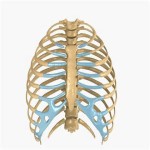Is Rib Reshaping Better Than Rib Removal For Waistline Narrowing?
Q: Dr. Eppley, I was reading an article by a male to female transgender woman who mentioned having a procedure in Mexico where the doctor broke her lower ribs and wrapped them tightly so that they would fuse together in a more narrow position. I am a slim young woman who would like a more narrow rib cage to give me a longer more narrow waist, but would like to keep my ribs if at all possible. I assume this would be called “rib manipulation” since it is the controlled breaking of the lower ribs. Have you heard of this being done for cosmetic purposes and can you give me information on the pros and cons of this procedure?
 A: What you are referring to would be known as rib reshaping by osteotomies as opposed to the more traditional rib removal procedure to make a more narrow rib cage. The rib as it extends from the spine and around the side of the body is composed of bone (from the spine out to about halfway around the side of the body) and then becomes softer cartilage as it extends to join the sternum. (ribs 10 through 12, also known as the ‘free floaters’ do not extend to the sternum…which turns out to be a very important point in this discussion) If the rib is osteotomized (cut) at the bone-cartilage junction, the cartilaginous end would be more bendable and theoretically could be molded inward as it heals for a more narrow waistline with after surgery binding. This would only apply to the free floating ribs which do not have an attached end. It would not work for any higher ribs because they have a complete arc around the body with a fixed point to the sternum.
A: What you are referring to would be known as rib reshaping by osteotomies as opposed to the more traditional rib removal procedure to make a more narrow rib cage. The rib as it extends from the spine and around the side of the body is composed of bone (from the spine out to about halfway around the side of the body) and then becomes softer cartilage as it extends to join the sternum. (ribs 10 through 12, also known as the ‘free floaters’ do not extend to the sternum…which turns out to be a very important point in this discussion) If the rib is osteotomized (cut) at the bone-cartilage junction, the cartilaginous end would be more bendable and theoretically could be molded inward as it heals for a more narrow waistline with after surgery binding. This would only apply to the free floating ribs which do not have an attached end. It would not work for any higher ribs because they have a complete arc around the body with a fixed point to the sternum.
The advantages to rib reshaping is that it would be less invasive since the ribs are not being removed, would have an easier recovery, may be able to be be done with a smaller incision on each side and would preserve the ribs. The disadvantages is that it is not really clear if it would really work and could be a source of chronic pain if the separated rib area do not heal. (osteochondritis)
Dr. Barry Eppley
Indianapolis, Indiana

North Meridian Medical Building
Address:
12188-A North Meridian St.
Suite 310
Carmel, IN 46032
Contact Us:
Phone: (317) 706-4444
WhatsApp: (317) 941-8237
